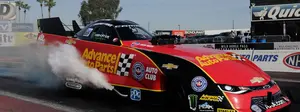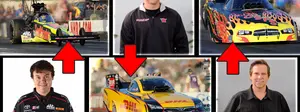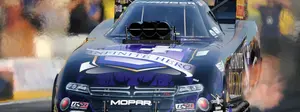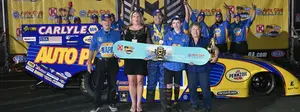

From the shop to the track

Representatives of each of the teams mentioned were willing to talk in great detail about the undertaking of an in-house fabrication department and what is involved in getting Top Fuel dragsters and Funny Cars from the chassis jig to the racetrack.
DSR fabrication manager Joe Fitzpatrick has been with the multicar organization since the end of the 2005 season when he was hired by Mike Neff. He has gone from mounting bodies to leading a six-person team of fabricators that build race cars and parts for seven teams. Fitzpatrick shared his insight into what goes on in the fabrication shop at DSR headquarters in Brownsburg, Ind.

We built our first Funny Car chassis early spring in 2008. We built our first Top Fuel chassis in the summer of 2009. The first Funny Car chassis went to Jack Beckman, and they debuted it in Englishtown in 2008.
How big of an undertaking was getting that program going?
It was a pretty big undertaking. John Force had his crash in Dallas in 2007, and NHRA made some changes with SFI to make the tubing a more robust area. The cost was going to be incredible for all of our teams to get new cars. That’s when Don pretty much said we need to start building cars in-house for that sole reason.
Not only is it the cost, but it’s the time frame. Bringing it all in-house, we can have more of a routine maintenance schedule, and we can control the timeline better if something happens rather than if we had to send things out to get them done.
How many fabricators are working in the shop full time?
We have six people who work in our fab shop. Two of those people solely do composite work – repairing of bodies and building anything carbon. With that, we started making some other investments to make more of our own things in-house. Like anything else that Don has done, it starts out small and then steamrolls up. There is enough work between those seven teams to keep us pretty busy throughout the year. The offseason is our race season for us in the fab shop and in our machine shop. Going through and making the changes, doing the updates, and whatever new idea that we want to try makes it a busy place to be sometimes.
How much work do the Funny Car bodies add?
Since we’ve switched to the new Charger body, we got the first of the new Charger design in October of 2014. Since then, we’ve mounted 19 bodies. Bodies keep us pretty busy. It’s not just the mounting of them but the upkeep and the maintenance. It’s something that the regular fan might not realize. If they lose control out the top end and mow over a cone, that can come back and have an extensive amount of work needed to be done before it can hit the track again. When one of the cars sneezes a blower off, the repair that goes into that is quite a bit of work. With the dragsters running the canopy and carbon-fiber bodies and even the belly pan there, they need repairs when they blow up. Those are enough to keep the two guys in the carbon shop going.

We build more Top Fuel chassis than Funny Car chassis. Since 2008, we’ve built 19 Funny Car chassis. Since 2009, we’ve built 27 Top Fuel cars. In that time, we’ve changed our Top Fuel program a couple different times and changed the fixturing. We’ll probably build one car per team per year, sometimes two. Every time we make a change to the chassis and car validates that the change has worked; we’ll build another car for the team to use as a spare.
We are currently working on our brand-new Funny Car design that we have been working with Chrysler with. It’s nearing completion. We are working on fixturing right now to build the first car with. We are doing some testing in the shop to quantify the new chassis to the old chassis. Once we get through that process, we are probably going to build four to eight Funny Car chassis very rapidly to get everybody their new cars at midseason this year.

As far as upkeep, we’ll front-half each one of our Funny Cars once to twice to three times per year. Beckman had a big wheelstand in testing that came down and bent the car, so it came back for an unscheduled front-half (pictured). Depending on what happens in testing could dictate how many times that car gets fronthalved and rebuilt throughout the year. Top Fuel cars get fronthalved a little more often than that. Lately, we’ll take our Funny Cars at 120 runs for a front-half. Dragsters will go anywhere from 50 to 60 to 70 runs before a front-half. It depends on how competitive that car is throughout the year and how many runs they make to dictate our front-half schedule.
How do you balance the scheduled and unscheduled work?
It’s a delicate balancing act. We have weekly crew chief and production meetings, where issues will be brought up or we can lay out a schedule of when they want a front-half to happen. What will usually happen is they will want to front-half at the end of the year over the offseason so they can go into testing with a fresh car. That’s also when a new car would come into service. A lot of people will try to front-half before the Western Swing or before the Indy test session right after Brainerd.

What else do you make besides the chassis?
Since I first started when we were just mounting Funny Car bodies to where we are now, pretty much if it has a weld on it, it comes from us. There are still a few things we buy from Murf McKinney. We build frames, wing trees, stay rods, puke tanks, kits for the canopy, all Top Fuel headers, starting to get back into the Funny Car header program, and a whole lot of parts and pieces. There are more things we make than what we don’t, and we’ve been approached about adding the things we don’t make into our parts and pieces, too. It’s an ever-expanding thing we try to keep up on.



























